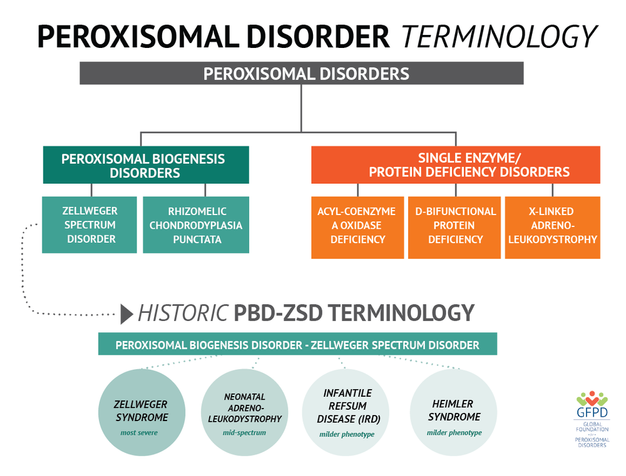
The GFPD was founded in 2010 to fill an unmet need to provide support to families facing one of several types of peroxisomal disorders. Today, we provide targeted support to patients affected by peroxisomal biogenesis disorder-Zellweger spectrum disorder and the related single enzyme deficiencies.
Generally speaking, peroxisomal disorders can be broken into two categories: peroxisomal biogenesis disorders and single enzyme/protein deficiency disorders. They are diagnosed and treated similarly but caused by different genetic mutations. Peroxisomal biogenesis disorders affect the overall assembly and function of the entire peroxisome, whereas, single enzyme/protein deficiency disorders affect the function of one of the many enzymes or another protein within peroxisomes.
Zellweger spectrum disorder is a type of peroxisomal biogenesis disorder and is often referred to as PBD-ZSD. Rhizomelic Chondrodyplasia Punctata (also known as RCDP) is also a peroxisomal biogenesis disorder, but the treatments and diagnosis for RCDP are vastly different from those of PBD-ZSD. We encourage any patient or caregiver to get in touch with our partners Rhizokids International for the best information on potential treatments and support for RCDP.
Many families have heard peroxisome biogenesis disorder-Zellweger spectrum disorder (PBD-ZSD) referred to by other names, including referring to the most severe phenotype as Zellweger syndrome (ZS), referring to a mid-spectrum phenotype as neonatal adrenoleukodystrophy (NALD), and milder phenotypes referred to as infantile Refsum disease (IRD) or Heimler syndrome. In recent years these disorders that were formerly grouped into separate diseases, are now known to be a continuum or spectrum disease with varying degrees of severity under the Zellweger spectrum disorder name. Although less common now, you may occasionally hear PBD-ZSD referred to by any of these former names.

